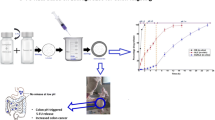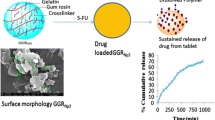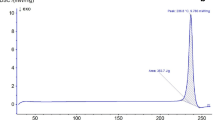Abstract
The aim of the study was to prepare 5-fluorouracil (5-FU)-loaded biogenic gold nanoparticles with pluronic-based coating (PFGNPs), their optimization (full factorial predicted OBPN-1) and in vitro-ex vivo evaluation. Several formulations were prepared, selected for optimization using Design Expert®, and compared for morphology, 5-FU release kinetics, compatibility, cell line toxicity, in vitro hemocompatibility, and ex vivo intestinal permeation across the rat duodenum, jejunum, and ileum. The pluronic-coated 5-FU-carrying GNPs were spherical, 29.11–178.21 nm in diameter, with a polydispersity index (PDI) range of 0.191–292, and a zeta potential (ZP) range of 11.19–29.21 (-mV). The optimized OBPN-1 (desirability = 0.95) demonstrated optimum size (175.1 nm), %DL as 73.8%, ZP as 21.7 mV, % drug release (DR) as 75.7%, and greater cytotoxicity (viability ~ 8.9%) against the colon cancer cell lines than 5-FU solution (~ 24.91%), and less hemocompatibility. Moreover, OBPN-1 exhibited 4.5-fold permeation across the rat jejunum compared with 5-FU solution. Thus, the PFGNPs exhibit high DL capacity, sustained delivery, hemocompatibility, improved efficacy, and enhanced permeation profiles compared with 5-FU solution and several other NPs preparations suggesting it is a promising formulation for effective colon cancer control with reduced side effects.











Similar content being viewed by others
Change history
25 February 2021
A Correction to this paper has been published: https://doi.org/10.1208/s12249-021-01954-7
References
World Health Organization (WHO) (2018) https://www.who.int/news-room/fact-sheets/detail/cancer).
Torre LA, Siegel RL, Jemal AL. Lung cancer statistics: in lung cancer and personalized medicine. Springer Cham. 2016;893:1–9.
Daga A, Ansari A, Patel S, Mirza S, Rawal R, Umrania V. Current drugs and drug targets in non-small cell lung cancer: limitations and opportunities. Asian Pac J Cancer Prev. 2015;16(10):4147–56.
Guo T, Holzberg TR, Lim CG, Gao F, Gargava A, Trachtenberg JE, et al. 3D printing PLGA: a quantitative examination of the effects of polymer composition and printing parameters on print resolution. Biofabrication. 2017;9(2):12–23.
Huang CY, Ju DT, Chang CF, Reddy PM, Velmurugan BK. A review on the effects of current chemotherapy drugs and natural agents in treating non–small cell lung cancer. Biomedicine. 2017;7(4):23. https://doi.org/10.1051/bmdcn/2017070423.
Lee JJ, Beumer JH, Chu E. Therapeutic drug monitoring of 5-fluorouracil. Cancer Chemother Pharmacol. 2016;78(3):447–64.
Chaudhary S, Umar A, Mehta SK. Surface functionalized selenium nanoparticles for biomedical applications. J Biomed Nanotechnol. 2014;10(10):3004–42.
Liu W, Li X, Wong YS, Zheng W, Zhang Y, Cao W, et al. Selenium nanoparticles as a carrier of 5-fluorouracil to achieve anticancer synergism. ACS Nano. 2012;6(8):6578–91.
Ohya Y, Takei T, Kobayashi H, Ouchi T. Release behaviour of 5-fluorouracil from chitosan-gel microspheres immobilizing 5-fluorouracil derivative coated with polysaccharides and their cell specific recognition. J Microencapsul. 1993;10(1):1–9.
Wen H, Jung H, Li X. Drug delivery approaches in addressing clinical pharmacology-related issues: opportunities and challenges. AAPS J. 2015;17(6):1327–40.
Gentile P, Chiono V, Carmagnola I, Hatton P. An overview of poly (lactic-co-glycolic) acid (PLGA)-based biomaterials for bone tissue engineering. Int J Mol Sci. 2014;15(3):3640–59.
Safwat MA, Soliman GM, Sayed D, Attia MA. Gold nanoparticles enhance 5-fluorouracil anticancer efficacy against colorectal cancer cells. Int J Pharm. 2016;513(1–2):648–58.
Alakhov V, Kabanov A. Block copolymer-based formulations of doxorubicin efective against drug resistant tumours, in Biomedical Polymers and Polymer Therapeutics, E. Chiellini, J. Sunamoto, C. Migliaresi, R. M. Ottenbrite, and D. Cohn, Eds., pp. 121–137, Kluwer Academic, New York, NY, USA, 2002.
Kabanov AV, Batrakova EV, Alakhov VY. Pluronic block copolymers as novel polymer therapeutics for drug and gene delivery. J Control Release. 2002;82(2–3):189–212.
Alakhov VY, Moskaleva EY, Batrakova EV, Kabanov AV. Hypersensitization of multidrug resistant human ovarian carcinoma cells by pluronic P85 block copolymer. Bioconjug Chem. 1996;7(2):209–16.
Han J, Zhao D, Li D, Wang X, Jin Z, Zhao K. Polymer-based nanomaterials and applications for vaccines and drugs. Polymers. 2018;10(1):1–14.
Martins C, Sousa F, Araujo F, Sarmento B. Functionalizing PLGA and PLGA derivatives for drug delivery and tissue regeneration applications. Adv Healthc Mater. 2018;7(1):1701035. https://doi.org/10.1002/adhm.201701035.
Mu L, Feng SS. A novel controlled release formulation for the anticancer drug paclitaxel (Taxol®): PLGA nanoparticles containing vitamin E TPGS. J Control Release. 2003;86(1):33–48.
Lee SY, Cho HJ. Dopamine-conjugated poly (lactic-co-glycolic acid) nanoparticles for protein delivery to macrophages. J Colloid Interface Sci. 2017;490:391–400.
Cleland JL, Mac A, Boyd B, Yang J, Duenas ET, Yeung D, et al. The stability of recombinant human growth hormone in poly (lactic-co-glycolic acid) (PLGA) microspheres. Pharm Res. 1997;14(4):420–5.
Dai J, Long W, Liang Z, Wen L, Yang F, Chen G. A novel vehicle for local protein delivery to the inner ear: injectable and biodegradable thermosensitive hydrogel loaded with PLGA nanoparticles. Drug Dev Ind Pharm. 2018;44(1):89–98.
Bailey BA, Desai KG, Ochyl LJ, Ciotti SM, Moon JJ, Schwendeman SP. Self-encapsulating poly (lactic-co-glycolic acid) (PLGA) microspheres for intranasal vaccine delivery. Mol Pharm. 2017;14(9):3228–37.
Silva AL, Soema PC, Slütter B, Ossendorp F, Jiskoot W. PLGA particulate delivery systems for subunit vaccines: linking particle properties to immunogenicity. Hum Vaccines Immunother. 2016;2(4):1056–69.
Boisselier E, Astruc D. Gold nanoparticles in nanomedicine: preparations, imaging, diagnostics, therapies and toxicity. Chem Soc Rev. 2009;38:1759–82.
Safwat MA, Soliman GM, Sayed D, Attia MA. Gold nanoparticles capped with benzalkonium chloride and poly (ethylene imine) for enhanced loading and skin permeability of 5-fluorouracil. Drug Dev Ind Pharm. 2017;43(11):1780–91.
Safwat MA, Soliman GM, Sayed D, Attia MA. Fluorouracil-loaded gold nanoparticles for the treatment of skin cancer: development, in vitro characterization, and in vivo evaluation in a mouse skin cancer xenograft model. Mol Pharm. 2018;15(6):2194–205.
Mohammad O, Faisal SM, Ahmad N, Rauf MA, Umar MS, Mujeeb AA, Pachauri P, Ahmed A, Kashif M, Ajmal M, Zubair S. Bio-mediated synthesis of 5-FU based nanoparticles employing orange fruit juice: a novel drug delivery system to treat skin fibrosarcoma in model animals. Sci Rep. 2019; 23;9(1):12288.
Singh S, Vidyarthi AS, Nigam VK, Dev A. Extracellular facile biosynthesis, characterization and stability of gold nanoparticles by Bacillus licheniformis. Artif Cells Nanomed Biotechnol. 2014:1–7.
Sharma N, Pinnaka AK, Raje M, FNU A, Bhattacharyya MS, Choudhury AR. Exploitation of marine bacteria for production of gold nanoparticles. Microb Cell Factories. 2012;11:86.
Murawala P, Tirmale A, Shiras A, Prasad BLV. In situ synthesized BSA capped gold nanoparticles: effective carrier of anticancer drug methotrexate to MCF-7 breast cancer cells. Mater Sci Eng C. 2014;34:158–67.
Zhang Z, Wang X, Li B, Hou Y, Yang J, Yi L. Development of a novel morphological paclitaxel-loaded PLGA microspheres for effective cancer therapy: in vitro and in vivo evaluations. Drug Deliv. 2018;25(1):166–77.
Ahmad N, Alam MA, Ahmad R, Naqvi AA, Ahmad FJ. Preparation and characterization of surface-modified PLGA-polymeric nanoparticles used to target treatment of intestinal cancer. Artif Cells Nanomed Biotechnol. 2018;46(2):432–46.
Pan X, Zhang X, Sun H, Zhang J, Yan M, Zhang H. Autophagy inhibition promotes 5-fluorouraci-induced apoptosis by stimulating ROS formation in human non-small cell lung cancer A549 cells. PLoS One. 2013;8(2):e56679.
Hussain A, Haque MW, Singh SK, Ahmed FJ. Optimized permeation enhancer for topical delivery of 5-fluorouracil-loaded elastic liposome using design expert: part II. Drug Deliv. 2015;23(4):1242–53.
Dash V, Mishra SK, Singh M, Goyal AK, Rath G. Release kinetic studies of aspirin microcapsules from ethyl cellulose, cellulose acetate phthalate and their mixtures by emulsion solvent evaporation method. Sci Pharm. 2010;78(1):93–102.
Hussain A, Altamimi MA, Alshehri S, Imam SA, Shakeel F, Singh SK. Novel approach for transdermal delivery of rifampicin to induce synergistic anti-mycobacterial effects against cutaneous and systemic tuberculosis using a cationic nanoemulsion gel. Int J Nanomedicine. 2020;15:1073–94.
Hussain A, Singh SK, Singh N, Verma PRP. In vitro-in vivo in-silico simulation studies of anti-tubercular drugs doped with self-nanoemulsifying drug delivery system. RSC Adv. 2016;6:93147–61.
Ruan LP, Chen S, Yu BY, Zhu DN, Cordell GA, Qiu SX. Prediction of human absorption of natural compounds by the non-everted rat intestinal sac model. Eur J Med Chem. 2006;41(5):605–10.
Kumari M, Mishra A, Pandey S, Singh SP, Chaudhry V, Mudiam MKR, et al. Physicochemical condition optimization during biosynthesis lead to development of improved and catalytically efficient gold nano particles. Sci Rep. 2016;6:1–14.
Newton DW, Kluza RB. pKa values of medicinal compounds in pharmacy practice. Ann Pharmacother. 1978;12:546–54.
Arias J. Novel strategies to improve the anticancer action of 5-fluorouracil by using drug delivery systems. Molecules. 2008;13:2340–69.
Ortiz R, Prados J, Melguizo C, Arias JL, Ruiz MA, Álvarez PJ, et al. 5-fluorouracil-loaded poly(ε-caprolactone) nanoparticles combined with phage E gene therapy as a new strategy against colon cancer. Int J Nanomedicine. 2012;7:95–107.
Gerweck LE, Vijayappa S, Kozin S. Tumor pH controls the in vivo efficacy of weak acid and base chemotherapeutics. Mol Cancer Ther. 2006;5:1275–9.
Sun SB, Liu P, Shao FM, Miao QL. Formulation and evaluation of PLGA nanoparticles loaded capecitabine for prostate cancer. Int J Clin Exp Med. 2015;8(10):19670–81.
Matai I, Sachdev A, Gopinath P. Multicomponent 5-fluorouracil loaded PAMAM stabilized-silver nanocomposites synergistically induce apoptosis in human cancer cells. Biomater Sci. 2015;3(3):457–68.
Kim D, Jeong YY, Jon S. A drug-loaded aptamer - gold nanoparticle bioconjugate for combined CT imaging and therapy of prostate cancer. ACS Nano. 2010;4:3689–96.
Kulkarni SA, Feng SS. Effects of particle size and surface modification on cellular uptake and biodistribution of polymeric nanoparticles for drug delivery. Pharm Res. 2013;30(10):2512–22.
Jain N, Bhargava A, Panwar J. Enhanced photocatalytic degradation of methylene blue using biologically synthesized “proteincapped” ZnO nanoparticles. Chem Eng. 2014; J 243: 549–555.
Giteau A, Venier-Julienne MC, Aubert-Pou¨essel A, Benoit JP How to achieve sustained and complete protein release from PLGA-based microparticles Int J Pharm 2008; 350: 14–26.
Udofot O, Affram K, Bridg’ette Israel EA. Cytotoxicity of 5-fluorouracil-loaded pH-sensitive liposomal nanoparticles in colorectal cancer cell lines. Integr Cancer Sci Ther. 2015;2:245.
Sylvestre JP, Kabashin AV, Sacher E, Meunier M, Luong JH. Nanoparticle size reduction during laser ablation in aqueous solutions of cyclodextrins, lasers and applications in science and engineering. Int Soc Opt Eng. 2004:84–92.
Bonengel S, Bernkop-Schnürch A. Thiomers—from bench to market. J Control Release. 2014;195:120–9.
Bhattacharjee S. DLS and zeta potential—what they are and what they are not? J Control Release. 2016;235:337–51.
Jeong B. Injectable biodegradable materials. In:Injectable biodegradable materials. Injectable Biomaterials: Woodhead Publishing Limited; 2011. p. 323–237. https://doi.org/10.1533/9780857091376.3.323.
Salama AH, Mahmoud AA, Kamel R. A novel method for preparing surface-modified Fluocinolone Acetonide loaded PLGA nanoparticles for ocular use: in vitro and in vivo evaluations. AAPS PharmSciTech. 2015;17(5):1159–72.
Leelakanok N, Geary S, Salem A. Fabrication and use of PLGA-based formulations designed for modified release of 5-fluorouracil. J Pharm Sci. 2018;107(2):513–28.
Alruwaili NK, Zafar A, Imam SS, Alharbi KS, Alshehri S, Elsamam T, Alomar FA, Akhtar S, Fahmi UA, Alhakamy NAA, Alshammari MS. Formulation of amorphous ternary solid dispersion of dapagliflozin using PEG 6000 and poloxamer 188: Solid-state characterization, ex vivo study, and molecular simulation assessment. Drug Development and Industrial Pharmacy. 2020: early online, doi: https://doi.org/10.1080/03639045.2020.1802482.
Singh R, Kesharwani P, Mehra NK, Singh S, Banerjee S, Jain NK. Development and characterization of folate anchored Saquinavir entrapped PLGA nanoparticles for anti-tumor activity. Drug Dev Ind Pharm. 2015;41(11):1888–901.
Hirsch LR, Stafford RJ, Bankson JA, Sershen SR, Rivera B, Price RE, et al. Nanoshell-mediated near-infrared thermal therapy of tumors under magnetic resonance guidance. PNAS. 2003;100:13549–54.
Kuroda K, Caputo GA. Antimicrobial polymers as synthetic mimics of host-defense peptides. WIREs Nanomed Nanobiotechnol. 2012;5:49–66.
Omura K. Clinical implications of dihydropyrimidine dehydrogenase (DPD) activity in 5-FU-based chemotherapy: mutations in the DPD gene, and DPD inhibitory fluoropyrimidines. Int J Clin Oncol. 2003;8:132–8.
Buur A, Trier L, Magnusson C, Artursson P. Permeability of 5-fluorouracil and prodrugs in caco-2 cell monolayers. Int J Pharm. 1996;29:223–31.
Artursson P, Ungell AL, Lofroth E. Selective paracellular permeability in two models of intestinal absorption: cultured monolayers of human intestinal epithelial cells and rat intestinal segments. Pharm Res. 1993;10:1123–9.
McCartney F, Rosa M, Brayden DJ. Evaluation of sucrose Laurate as an intestinal permeation enhancer for macromolecules: ex vivo and in vivo studies. Pharmaceutics. 2019;11:565. https://doi.org/10.3390/pharmaceutics11110565.
McCartney F, Janninb V, Chevrier S, Boulghobra H, Hristova DR, Ritter N, et al. Labrasol® is an efficacious intestinal permeation enhancer across rat intestine: ex vivo and in vivo rat studies. J Control Release. 2019;310:115–26.
Acknowledgements
The authors extend their appreciation to the Deputyship for Research & Innovation, “Ministry of Education” in Saudi Arabia for funding this research work through the project number (IFKSURG-1441-443).
Author information
Authors and Affiliations
Corresponding authors
Ethics declarations
Conflict of Interest
The authors declare that they have no conflict of interest.
Additional information
Publisher’s Note
Springer Nature remains neutral with regard to jurisdictional claims in published maps and institutional affiliations.
The original online version of this article was revised: During production, a type-setting error occurred in the acknowledgment section. The project number published was (IFKSURG-1442-443). The correct project number is (IFKSURG-1441-443).
Rights and permissions
About this article
Cite this article
Mahdi, W.A., Hussain, A., Ramzan, M. et al. Pluronic-Coated Biogenic Gold Nanoparticles for Colon Delivery of 5-Fluorouracil: In vitro and Ex vivo Studies. AAPS PharmSciTech 22, 64 (2021). https://doi.org/10.1208/s12249-021-01922-1
Received:
Accepted:
Published:
DOI: https://doi.org/10.1208/s12249-021-01922-1




